Impact of Open-Loop Systems on Groundwater Temperature in NE Slovenia
Abstract
:1. Introduction
2. The Study Area
3. Materials and Methods
3.1. Monitoring Network
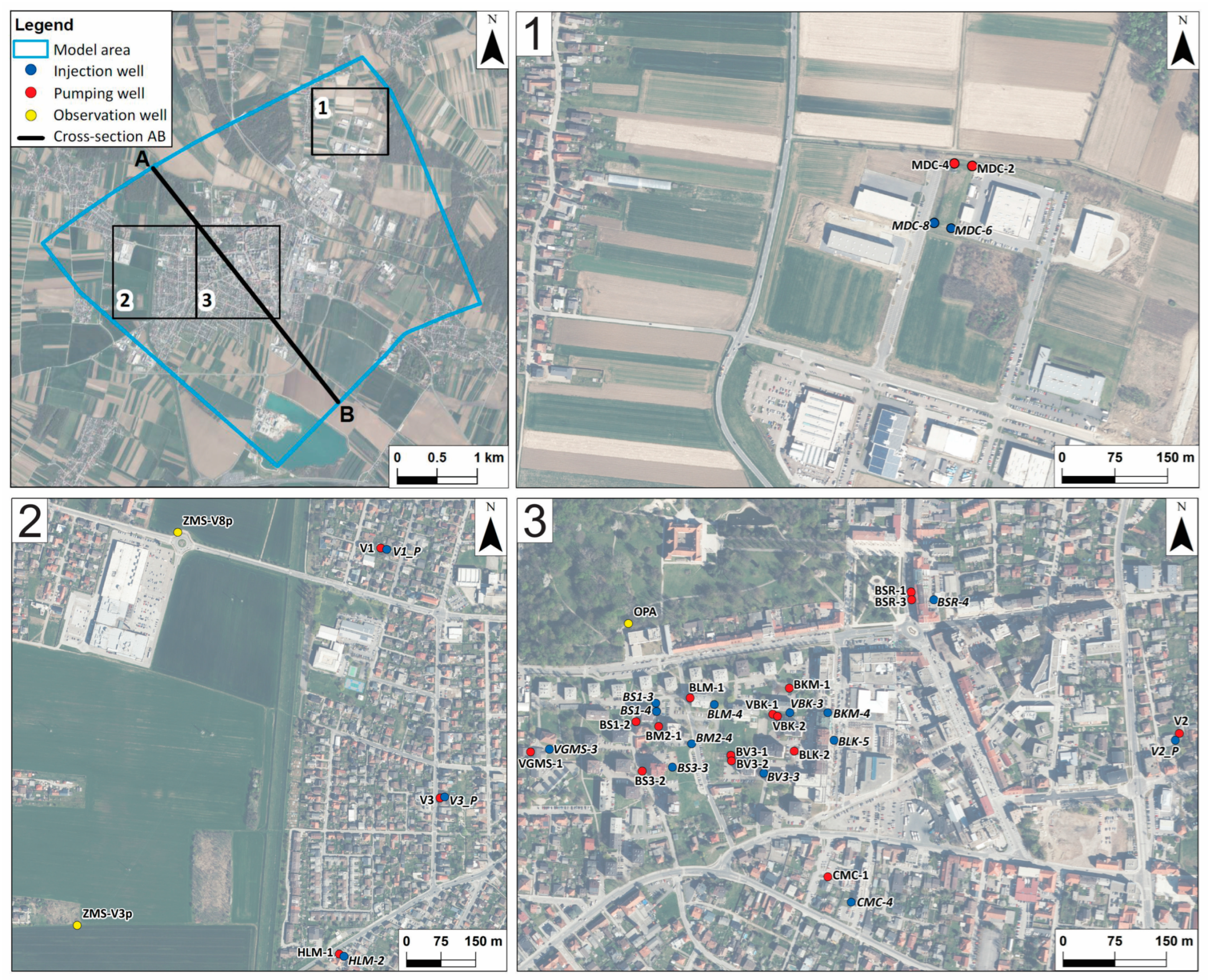
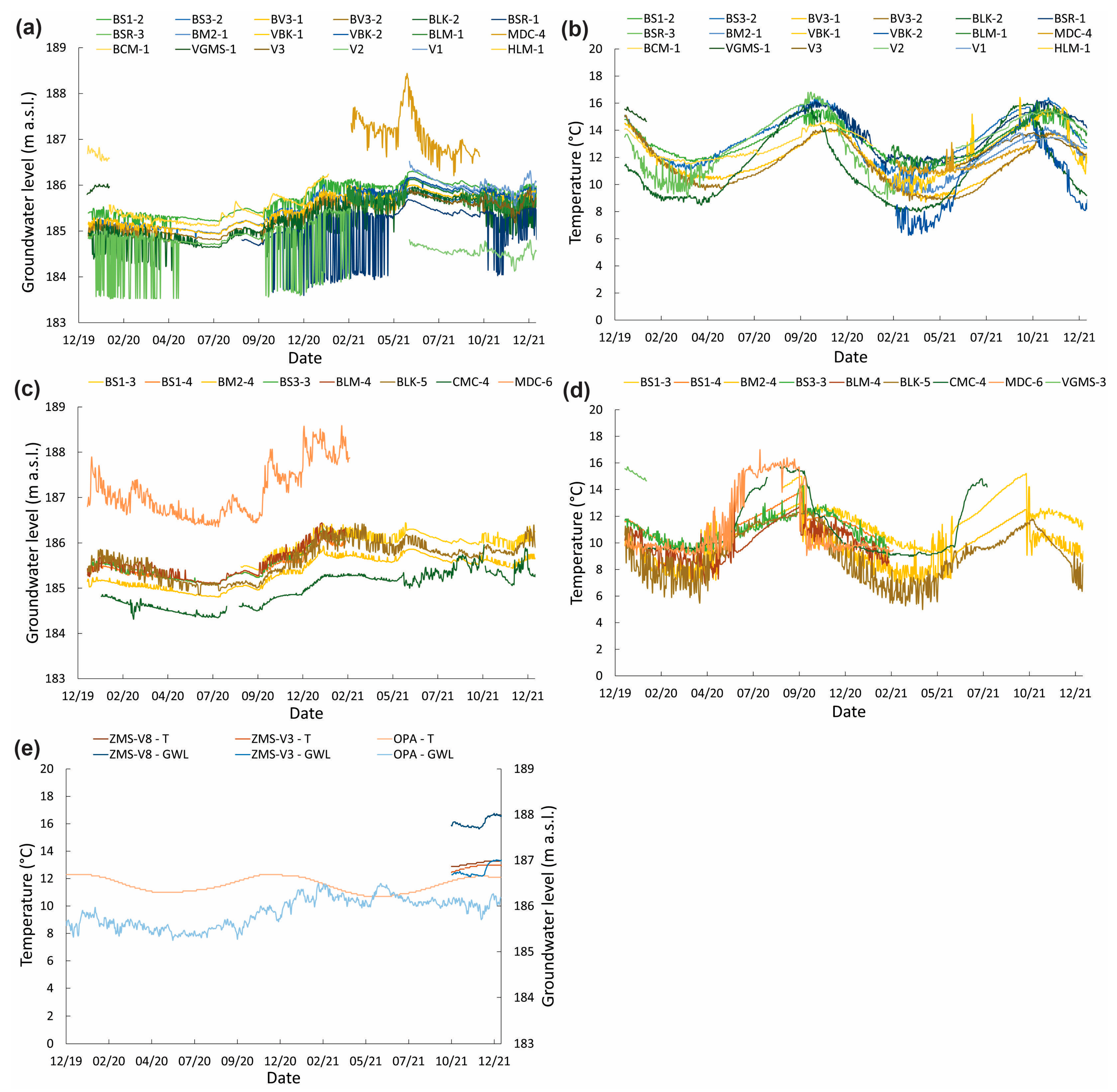

3.2. FEM Numerical Model
3.3. Model Setup
| Layer | |||
|---|---|---|---|
| 1 | 2, 3, 4 and 5 | 6 | |
| Layer thickness (m) | 0.1–12.5 | 4.8–18.5 | 10 |
| Material property | |||
| Hydraulic conductivity (ms−1) | 2.8 × 10−5 [a] | 1.0 × 10−3 [b] | 1 × 10−7 [c] |
| Effective porosity (Fluid) (-) | 0.4 [c] | 0.15 [a] | 0.5 [c] |
| Total porosity (Heat) (-) [d] | 0.5 | 0.25 | 0.6 |
| Volumetric heat capacity of solid material (MJm−3K−1) [d] | 1.5 | 2.5 | 2.5 |
| Thermal conductivity of solid material (Wm−1K−1) [d] | 1.5 | 3.0 | 3.7 |
3.4. Mesh Geometry
3.5. Boundary Conditions
3.6. Calibration and Validation
4. Results and Discussion
4.1. Calibration
4.2. Validation
4.3. Simulated Thermal Plumes Downgradient from Injection Wells
5. Conclusions
Author Contributions
Funding
Institutional Review Board Statement
Informed Consent Statement
Data Availability Statement
Acknowledgments
Conflicts of Interest
Appendix A
| Open-Loop System | Well Name with Assigned P/I Rate | Number of Pumping Wells | Number of Injection Wells |
|---|---|---|---|
| 1 | BS1-2/19 | 2 | 2 |
| BS1-3/19 | |||
| 2 | BM2-1/19 | 2 | 2 |
| BM2-4/19 | |||
| 3 | BS3-2/19 | 2 | 2 |
| BS3-3/19 | |||
| 4 | BLM-1/19 | 2 | 2 |
| BLM-4/19 | |||
| 5 | BLK-2/16 | 3 | 3 |
| BLK-5/16 | |||
| 6 | MDC-2/18 | 4 | 4 |
| MDC-6/18 | |||
| MDC-4/18 | |||
| MDC-8/18 | |||
| 7 | CMC-1/17 | 2 | 2 |
| CMC-4/17 | |||
| 8 | BKM-1/19 | 2 | 2 |
| BKM-4/19 | |||
| 9 | V1 | 1 | 1 |
| V1_P | |||
| 10 | V2 | 1 | 1 |
| V2_P | |||
| 11 | V3 | 1 | 1 |
| V3_P | |||
| 12 | VBK-1/16 | 2 | 2 |
| VBK-3/16 | |||
| 13 | BV3-1/19 | 2 | 2 |
| BV3-3/19 | |||
| 14 | BSR-1/19 | 3 | 1 |
| BSR-4/19 | |||
| 15 | VGMS-1/13 | 2 | 2 |
| VGMS-3/13 | |||
| 16 | HLM-1/14 | 1 | 1 |
| HLM-2/14 | |||
| Drinking water supply | F-V1 | 3 | / |
| F-V2 | |||
| F-V3 |

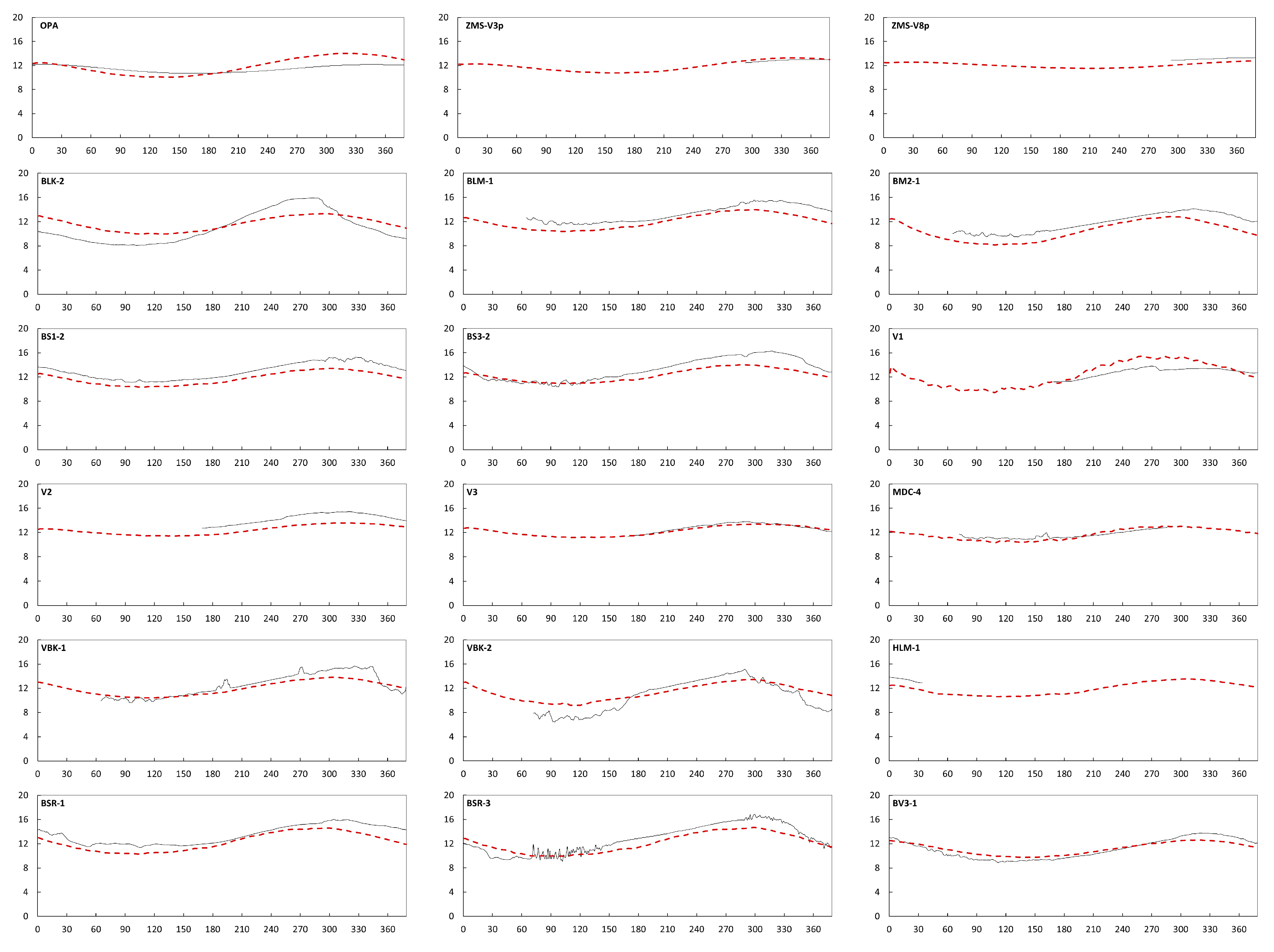

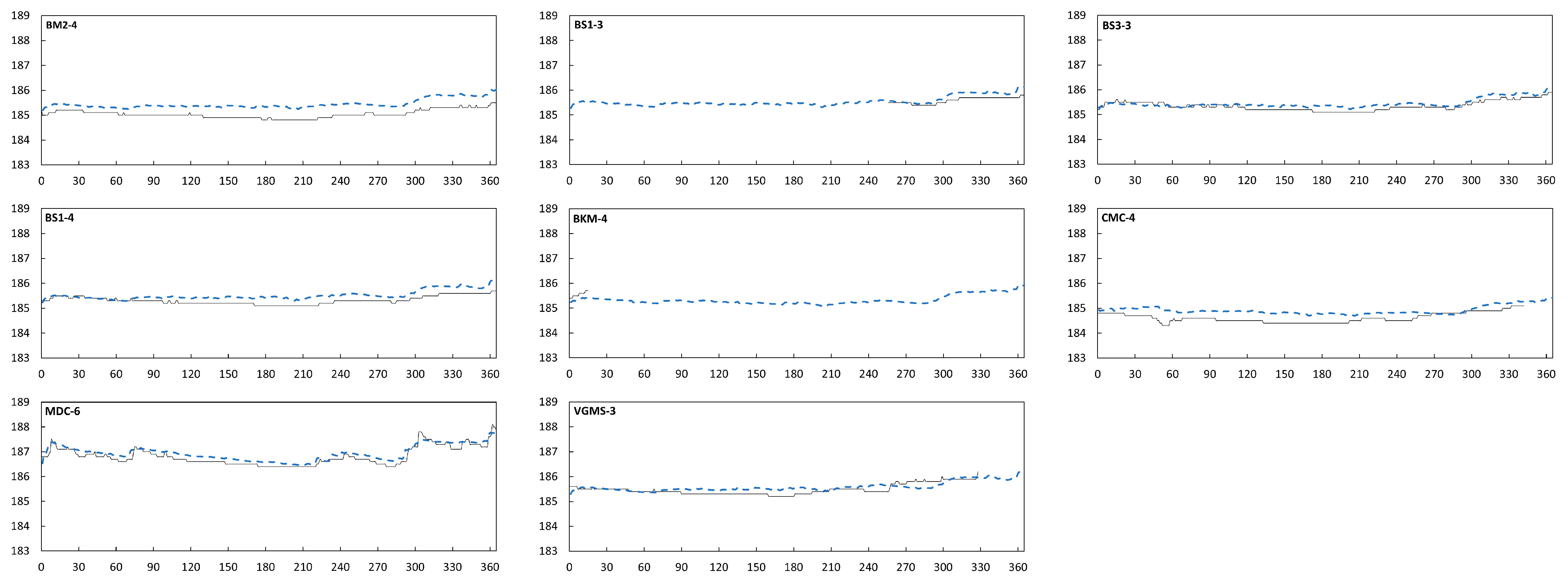
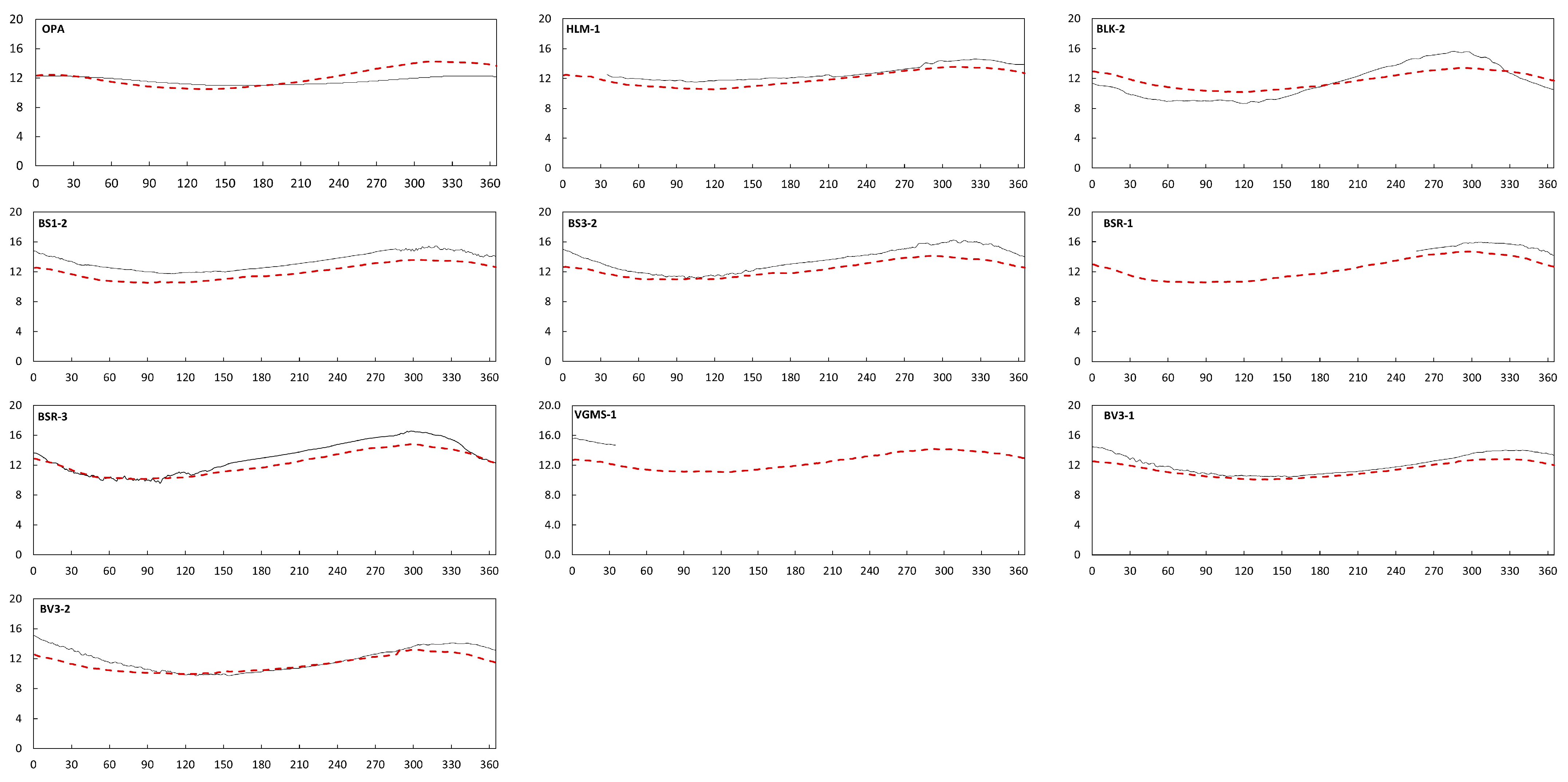


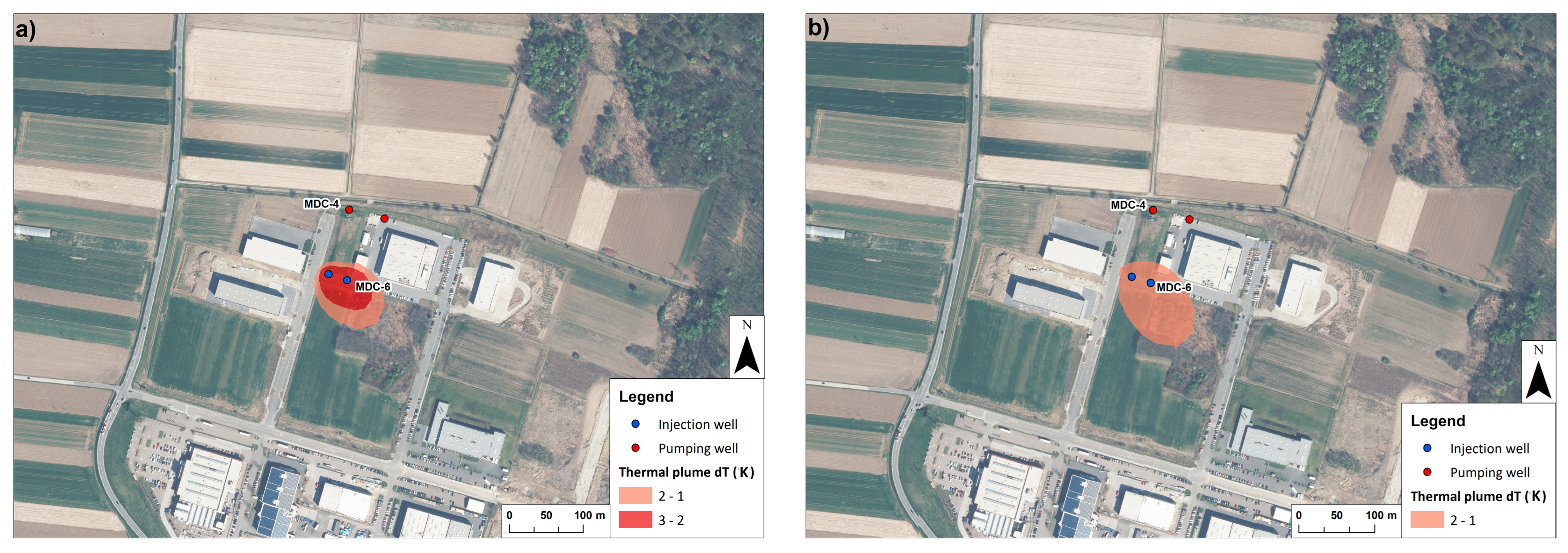
References
- European Council. Communication on REPowerEU: Joint European Action for More Affordable, Secure and Sustainable Energy, COM, 108 Final; European Council: Brussels, Belgium, 2022. [Google Scholar]
- Ministry of Infrastructure. Integrated National Energy and Climate Plan of the Republic of Slovenia; Ministry of Infrastructure: Ljubljana, Slovenia, 2020; 233p.
- Epting, J.; Handel, F.; Huggenberger, P. Thermal management of an unconsolidated shallow urban groundwater body. Hydrol. Earth Syst. Sci. 2013, 17, 1851–1869. [Google Scholar] [CrossRef]
- Garcia-Gil, A.; Schneider, E.; Moreno, M.; Santamarta, J. Shallow Geothermal Energy: Theory and Application; Springer: Cham, Switzerland, 2022. [Google Scholar]
- Banks, D. An Introduction to Thermogeology: Ground Source Heating and Cooling, 2nd ed.; Wiley-Blackwell: Hoboken, NJ, USA, 2012. [Google Scholar]
- EGEC. Geothermal Market Report 2020; European Geothermal Energy Council: Brussels, Belgium, 2021. [Google Scholar]
- Lund, J.W. Ground-Source (Geothermal) Heat Pumps. In Course on “Heating with Geothermal Energy: Conventional and New Schemes”; Lienau, P.J., Ed.; WGC2000 Short Courses: Kazuno, Japan, 2000; pp. 209–236. Available online: https://www.geothermal-energy.org/pdf/IGAstandard/ISS/2001Romania/lund_hp.pdf (accessed on 5 June 2022).
- De Moel, M.; Bach, P.M.; Bouazza, A.; Singh, R.M.; Sun, J.O. Technological advances and applications of geothermal energy pile foundations and their feasibility in Australia. Renew. Sustain. Energy Rev. 2010, 14, 2683–2696. [Google Scholar] [CrossRef]
- Chiasson, A.D. Geothermal Heat Pump and Heat Engine Systems—Theory and Practice; Wiley, Department of Mechanical and Aerospace Engineering, University of Dayton: Dayton, OH, USA, 2016. [Google Scholar]
- Kłonowski, M.; Kozdrój, W.; Götzl, G.; Heiermann, M. Summary Report on Existing Energy Planning Strategies in the EU Considering the Use of Shallow Geothermal Energy; Interreg Central Europe: Wien, Austria, 2018. [Google Scholar]
- Banks, D. The application of analytical solutions to the thermal plume from a well doublet ground source heating or cooling scheme. Q. J. Eng. Geol. Hydrogeol. 2011, 44, 191–197. [Google Scholar] [CrossRef]
- Molina-Giraldo, N.; Bayer, P.; Blum, P. Evaluating the influence of thermal dispersion on temperature plumes from geothermal systems using analytical solutions. Int. J. Therm. Sci. 2011, 50, 1223–1231. [Google Scholar] [CrossRef]
- Wu, Q.; Tu, K.; Sun, H.; Chen, C. Investigation on the sustainability and efficiency of single-well circulation (SWC) groundwater heat pump systems. Renew. Energy 2019, 130, 656–666. [Google Scholar] [CrossRef]
- Al-Khoury, R. Computational Modeling of Shallow Geothermal Systems; Taylor & Francis Group: Abingdon, UK, 2012; Volume 4. [Google Scholar]
- Sass, I.; Brehm, D.; Coldewey, W.G.; Dietrich, J.; Klein, R.; Kellner, T.; Kirschbaum, B.; Lehr, C.; Marek, A.; Mielke, P.; et al. Shallow Geothermal Systems—Recommendations on Design, Construction, Operation and Monitoring; Wilhelm Ernst & Sohn: Berlin, Germany, 2016. [Google Scholar]
- Epting, J.; Huggenberger, P. Unraveling the heat island effect observed in urban groundwater bodies—Definition of a potential natural state. J. Hydrol. 2013, 501, 193–204. [Google Scholar] [CrossRef]
- Muela Maya, S.; García-Gil, A.; Garrido Schneider, E.; Mejías Moreno, M.; Epting, J.; Vázquez-Suñé, E.; Marazuela, M.Á.; Sánchez-Navarro, J.Á. An upscaling procedure for the optimal implementation of open-loop geothermal energy systems into hydrogeological models. J. Hydrol. 2018, 563, 155–166. [Google Scholar] [CrossRef]
- Attard, G.; Bayer, P.; Rossier, Y.; Blum, P.; Eisenlohr, L. A novel concept for managing thermal interference between geothermal systems in cities. Renew. Energy 2020, 145, 11. [Google Scholar] [CrossRef]
- Di Dato, M.; D’Angelo, C.; Casasso, A.; Zarlenga, A. The impact of porous medium heterogeneity on the thermal feedback of open-loop shallow geothermal systems. J. Hydrol. 2022, 604, 127205. [Google Scholar] [CrossRef]
- Previati, A.; Crosta, G.B. Regional-scale assessment of the thermal potential in a shallow alluvial aquifer system in the Po plain (northern Italy). Geothermics 2021, 90, 101999. [Google Scholar] [CrossRef]
- Lo Russo, S.; Taddia, G.; Verda, V. Development of the thermally affected zone (TAZ) around a groundwater heat pump (GWHP) system: A sensitivity analysis. Geothermics 2012, 43, 66–74. [Google Scholar] [CrossRef]
- Mueller, M.H.; Huggenberger, P.; Epting, J. Combining monitoring and modelling tools as a basis for city-scale concepts for a sustainable thermal management of urban groundwater resources. Sci. Total Environ. 2018, 627, 1121–1136. [Google Scholar] [CrossRef]
- Baden Württemberg Umweltministerium. Leitfaden zur Nutzung von Erdwärme mit Grundwasserwärmepumpen; Baden Württemberg Umweltministerium: Stuttgart, Germany, 2009.
- Pophillat, W.; Attard, G.; Bayer, P.; Hecht-Méndez, J.; Blum, P. Analytical solutions for predicting thermal plumes of groundwater heat pump systems. Renew. Energy 2018, 147, 2696–2707. [Google Scholar] [CrossRef]
- Böttcher, F.; Casasso, A.; Götzl, G.; Zosseder, K. TAP—Thermal aquifer Potential: A quantitative method to assess the spatial potential for the thermal use of groundwater. Renew. Energy 2019, 142, 85–95. [Google Scholar] [CrossRef]
- Epting, J.; García-Gil, A.; Huggenberger, P.; Vázquez-Suñe, E.; Mueller, M.H. Development of concepts for the management of thermal resources in urban areas—Assessment of transferability from the Basel (Switzerland) and Zaragoza (Spain) case studies. J. Hydrol. 2017, 548, 697–715. [Google Scholar] [CrossRef]
- Previati, A.; Epting, J.; Crosta, G.B. The subsurface urban heat island in Milan (Italy)—A modeling approach covering present and future thermal effects on groundwater regimes. Sci. Total Environ. 2022, 810, 152119. [Google Scholar] [CrossRef]
- García-Gil, A.; Mejías Moreno, M.; Garrido Schneider, E.; Marazuela, M.Á.; Abesser, C.; Mateo Lázaro, J.; Sánchez Navarro, J.Á. Nested Shallow Geothermal Systems. Sustainability 2020, 12, 5152. [Google Scholar] [CrossRef]
- García-Gil, A.; Muela Maya, S.; Garrido Schneider, E.; Mejías Moreno, M.; Vázquez-Suñé, E.; Marazuela, M.Á.; Mateo Lázaro, J.; Sánchez-Navarro, J.Á. Sustainability indicator for the prevention of potential thermal interferences between groundwater heat pump systems in urban aquifers. Renew. Energy 2019, 134, 14–24. [Google Scholar] [CrossRef]
- Pophillat, W.; Bayer, P.; Teyssier, E.; Blum, P.; Attard, G. Impact of groundwater heat pump systems on subsurface temperature under variable advection, conduction and dispersion. Geothermics 2020, 83, 101721. [Google Scholar] [CrossRef]
- Piga, B.; Casasso, A.; Pace, F.; Godio, A.; Sethi, R. Thermal Impact Assessment of Groundwater Heat Pumps (GWHPs): Rigorous vs. Simplified Models. Energies 2017, 10, 1385. [Google Scholar] [CrossRef]
- ARSO. Meteo Archive. Available online: https://meteo.arso.gov.si/met/sl/archive/ (accessed on 5 June 2022).
- Struckmeier, W.; Margat, J.F. Hydrogeological Maps: A Guide and a Standard Legend; Heise: Hannover, Germany, 1995. [Google Scholar]
- DRSV. Water Permits for Heat Use. Available online: https://vode.dv.gov.si/vdvpogled/Poizvedba.jsp (accessed on 5 June 2022).
- Vodna Knjiga. Ministrstvo za Naravne Vire in Prostor, Direkcija Republike Slovenije za Vode. Available online: https://podatki.gov.si/dataset/vodna-knjiga?resource_id=b852ff63-f0a2-42b7-abad-6975f9a7378e (accessed on 1 August 2023).
- GURS. Digitalni Ortofoto Posnetki DOF50. 2019. Available online: https://podatki.gov.si/dataset/ortofoto (accessed on 12 March 2022).
- ARSO. Hydrological Data Archive. Available online: http://vode.arso.gov.si/hidarhiv/ (accessed on 2 June 2022).
- Brenčič, M.; Bole, Z. Hidrogeološki Elaborat za Potrebe Idejnega Projekta Izvenivojskega Križanja z Železnico v Murski Soboti na R2-441/1298 (Lendavska); Geološki zavod Slovenije: Ljubljana, Slovenia, 2000; p. 20. [Google Scholar]
- Koren, K.; Brenčič, M.; Lapanje, A. Hydrogeology of the transition area between Prekmursko polje and Goričko (NE Slovenia). Geologija 2015, 58, 175–182. [Google Scholar] [CrossRef]
- Novak, M.; Bavec, M.; Trajanova, M. Lithological map of Slovenia. In Geological atlas of Slovenia, 2nd ed.; Novak, M., Rman, N., Eds.; Geological Survey of Slovenia: Ljubljana, Slovenia, 2016. [Google Scholar]
- Pleničar, M. Tolmač za Lista Goričko Osnovne Geološke Karte SFRJ 1:100,000; Zvezni Geološki Zavod Beograd: Belgrade, Serbia, 1970; p. 39. [Google Scholar]
- Mioč, P.; Markovič, S. Osnovna Geološka Karta R Slovenije in R Hrvaške—List Čakovec 1:100,000; Institut za Geoloska Istrazivanja: Zagreb, Croatia, 1998. [Google Scholar]
- Diersch, H.-J. FEFLOW: Finite Element Modeling of Flow, Mass and Heat Transport in Porous and Fractured Media; Springer Science & Business Media: New York, NY, USA, 2014. [Google Scholar]
- Ratej, J.; Kranjc, T.; Narat, D.; Kocjančič, M.; Ivačič, B. Hidrogeološki Elaborat za Potrebe Izvedbe Trase Vzhodne Obvoznice Murska Sobota od km 3+520 do km 6+940; IRGO Consulting d.o.o.: Ljubljana, Slovenia, 2018; p. 50. [Google Scholar]
- Prestor, J.; Strojan, M. Hidrogeološko Poročilo o Vodnjaku V-INOKS Galvanika, Podjetja “Inoks”—Izpostava Murska Sobota; Geološki zavod Slovenije: Ljubljana, Slovenia, 2004; p. 9. [Google Scholar]
- Bokan, A. Hydrogeological Reports for Water Permit of Individual Open-Loop Systems; GEO-VRTINA d.o.o.: Murska Sobota, Slovenia, 2020. [Google Scholar]
- Bokan, A. Hydrogeological Reports for Water Permit of Individual Open-Loop Systems; GEO-VRTINA d.o.o.: Murska Sobota, Slovenia, 2019. [Google Scholar]
- Bokan, A. Hydrogeological Reports for Water Permit of Individual Open-Loop Systems; GEO-VRTINA d.o.o.: Murska Sobota, Slovenia, 2017. [Google Scholar]
- Bokan, A. Hydrogeological Reports for Water Permit of Individual Open-Loop Systems; GEO-VRTINA d.o.o.: Murska Sobota, Slovenia, 2016. [Google Scholar]
- Bokan, A. Hydrogeological Reports for Water Permit of Individual Open-Loop Systems; GEO-VRTINA d.o.o.: Murska Sobota, Slovenia, 2015. [Google Scholar]
- Bokan, A. Hydrogeological Reports for Water Permit of Individual Open-Loop Systems; GEO-VRTINA d.o.o.: Murska Sobota, Slovenia, 2014. [Google Scholar]
- GURS. Digital Elevation Model. Available online: https://ipi.eprostor.gov.si/jgp/data (accessed on 24 March 2022).
- Bear, J.; Cheng, A.H.-D. Modeling Groundwater Flow and Contaminant Transport. In Theory and Applications of Transport in Porous Media; Reidel: Dordrecht, The Netherlands, 2010; Volume 23. [Google Scholar]
- Kasenow, M. Applied Ground-Water Hydrology and Well Hydraulics; Water Resources Publications: Highlands Ranch, CO, USA, 2010. [Google Scholar]
- Rajver, D. Map of Surface Heat-Flow Density. In Geological Atlas of Slovenia, 2nd ed.; Novak, M., Rman, N., Eds.; Geological Survey of Slovenia: Ljubljana, Slovenia, 2016. [Google Scholar]
- German Standard DWA-A 138E; Planning, Construction and Operation of Facilities for the Percolation of Precipitation. German Association for Water: Berlin, Germany, 2005; 60p.
- DHI-WASY. FEFLOW IFM Plugins. Available online: https://www.mikepoweredbydhi.com/download/mike-by-dhi-tools/groundwaterandporousmediatools/openloop%20plugin (accessed on 9 February 2022).
- DHI-Wasy. FePEST in FEFLOW 7.0 (FePEST User Manual); DHI-Wasy: Berlin, Germany, 2016. [Google Scholar]
- Park, B.-H.; Bae, G.-O.; Lee, K.-K. Importance of thermal dispersivity in designing groundwater heat pump (GWHP) system: Field and numerical study. Renew. Energy 2015, 83, 270–279. [Google Scholar] [CrossRef]
- Park, B.-H.; Lee, K.-K. Evaluating anisotropy ratio of thermal dispersivity affecting geometry of plumes generated by aquifer thermal use. J. Hydrol. 2021, 602, 126740. [Google Scholar] [CrossRef]
- Doherty, J. Model-Independent Parameter Estimation User Manual Part I: PEST, SENSAN and Global Optimisers; Watermark Numerical Computing: Brisbane, Australia, 2016; 390p. [Google Scholar]
- Perego, R.; Dalla Santa, G.; Galgaro, A.; Pera, S. Intensive thermal exploitation from closed and open shallow geothermal systems at urban scale: Unmanaged conflicts and potential synergies. Geothermics 2022, 103, 102417. [Google Scholar] [CrossRef]
- Permanda, R.; Ohtani, T. Thermal Impact by Open-Loop Geothermal Heat Pump Systems in Two Different Local Underground Conditions on the Alluvial Fan of the Nagara River, Gifu City, Central Japan. Energies 2022, 15, 6816. [Google Scholar] [CrossRef]
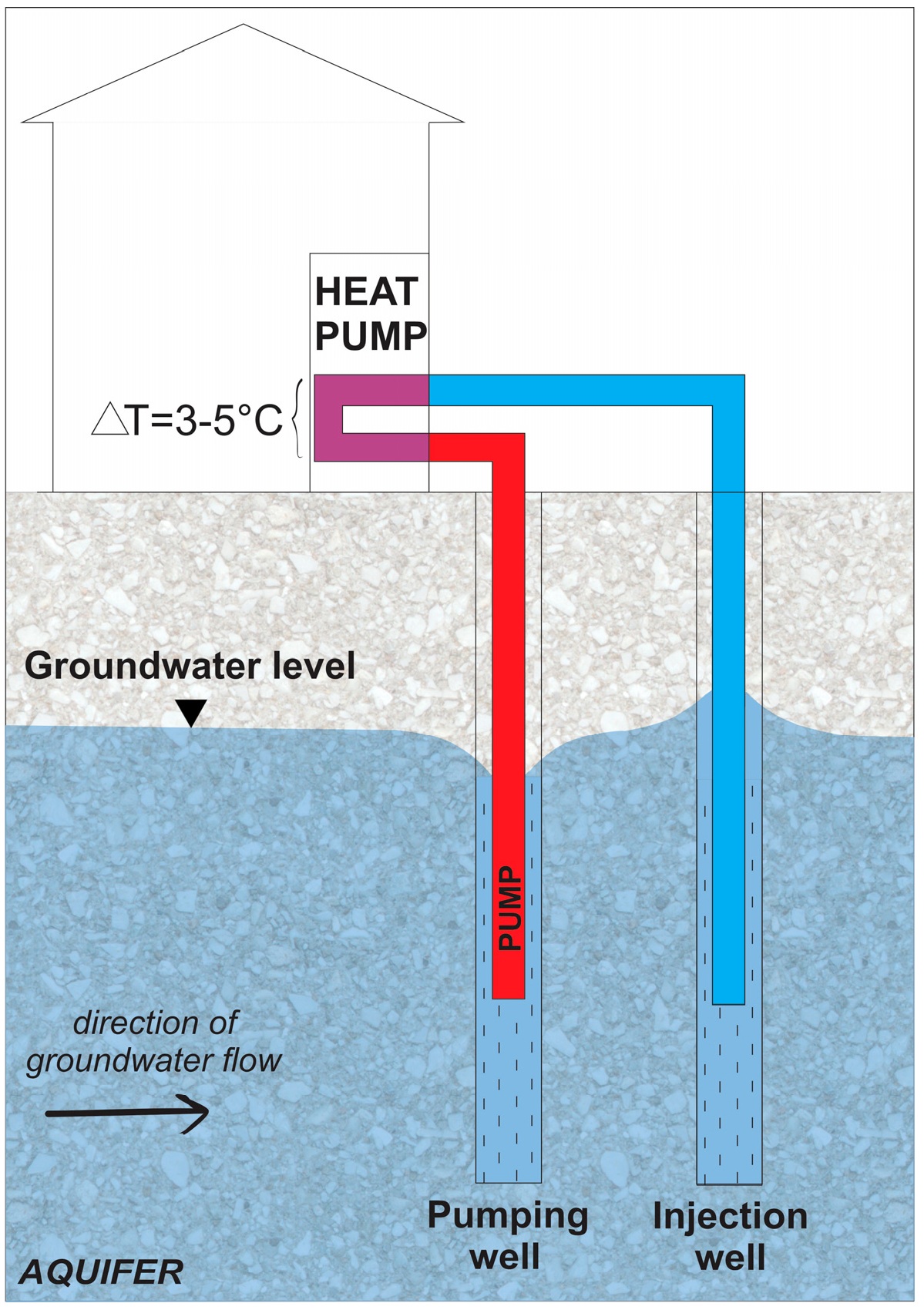
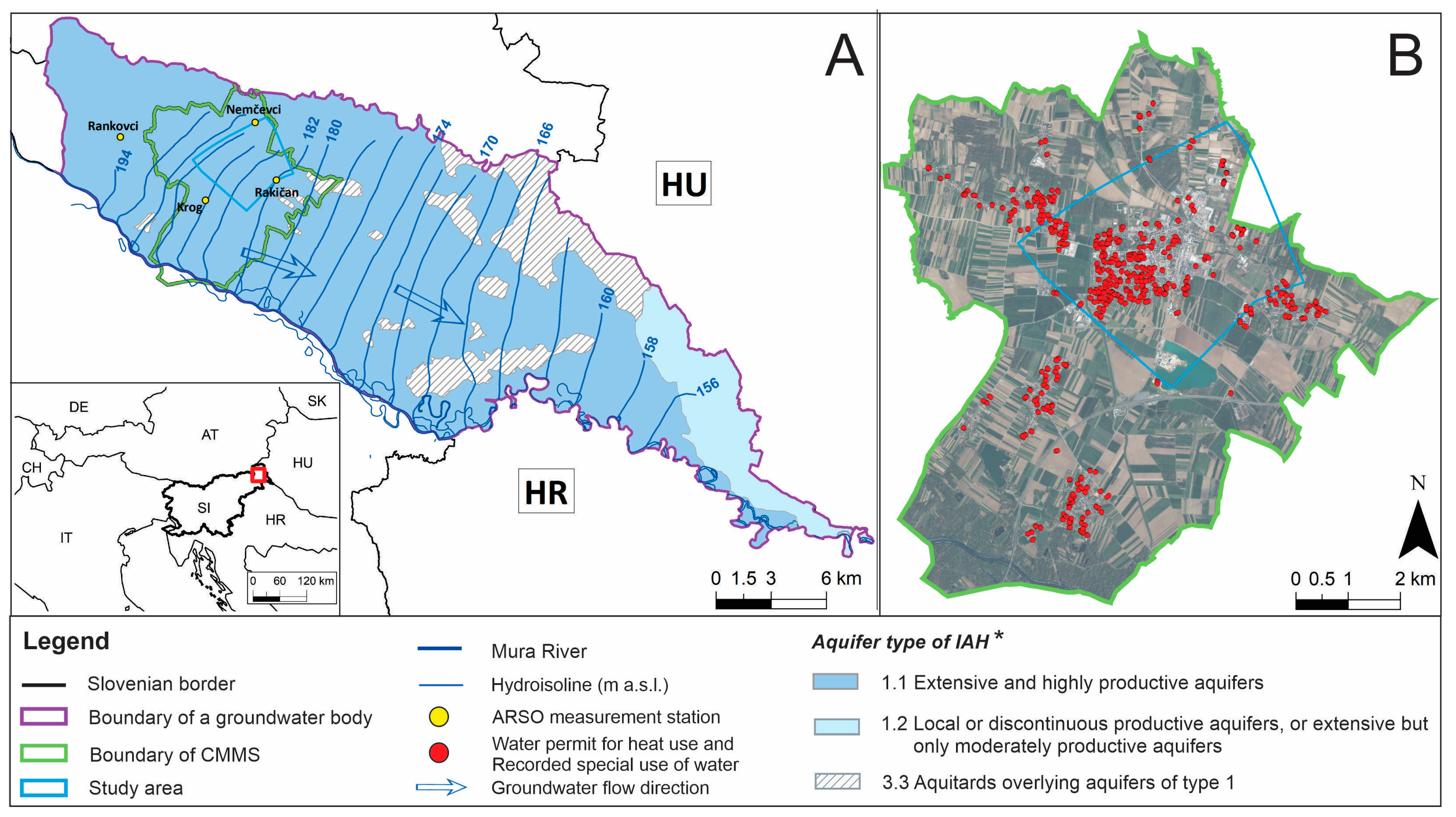
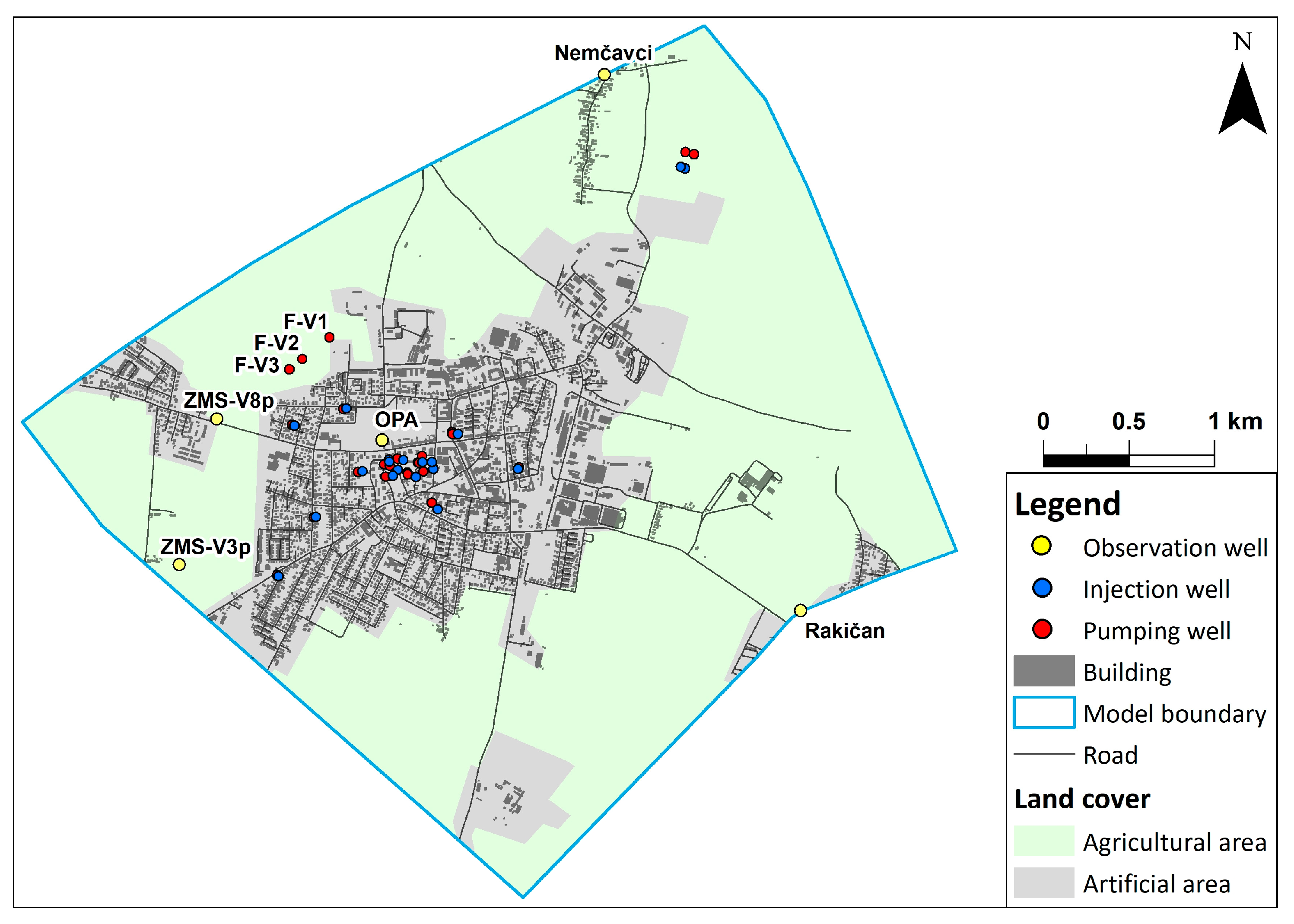

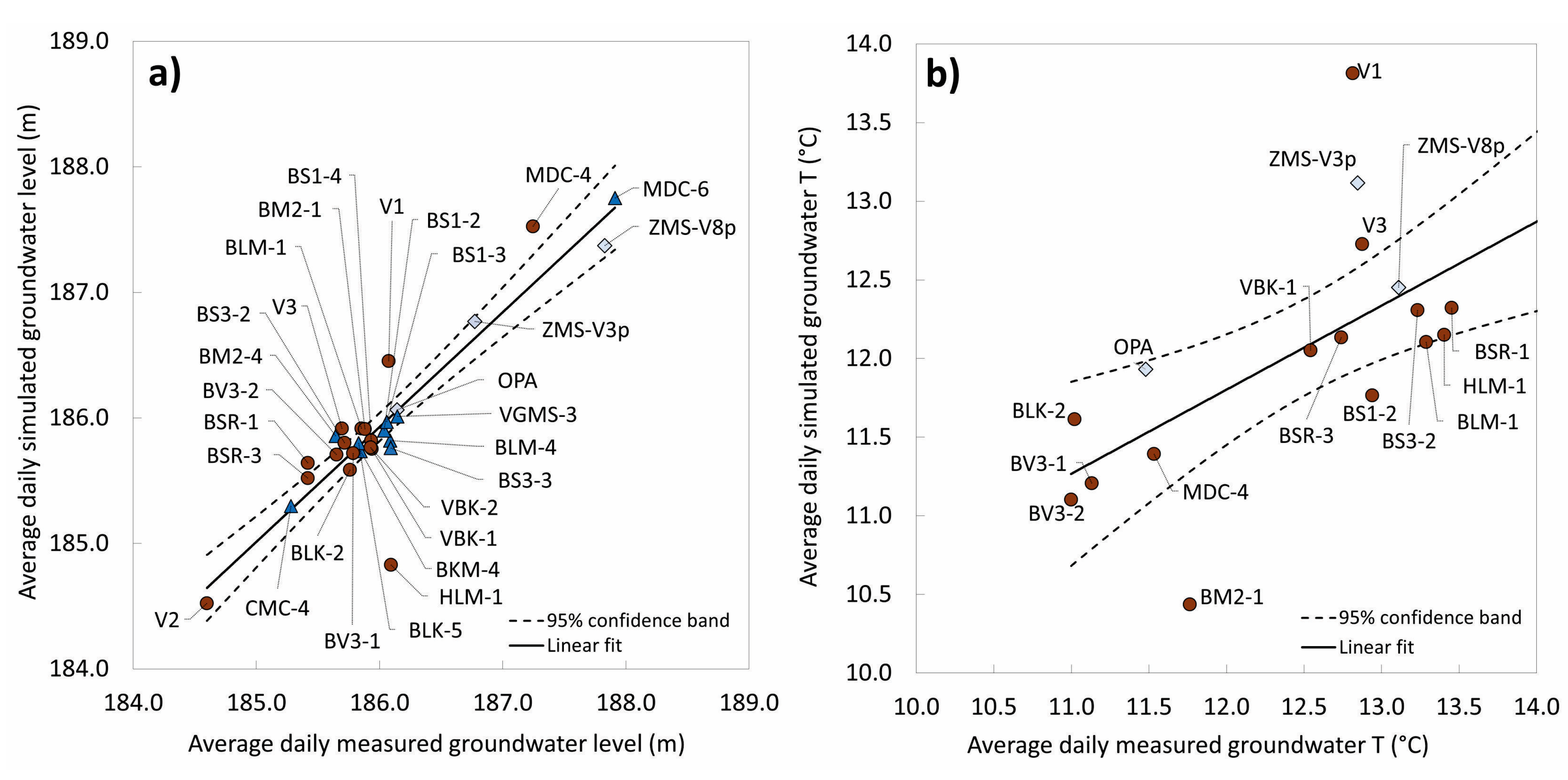
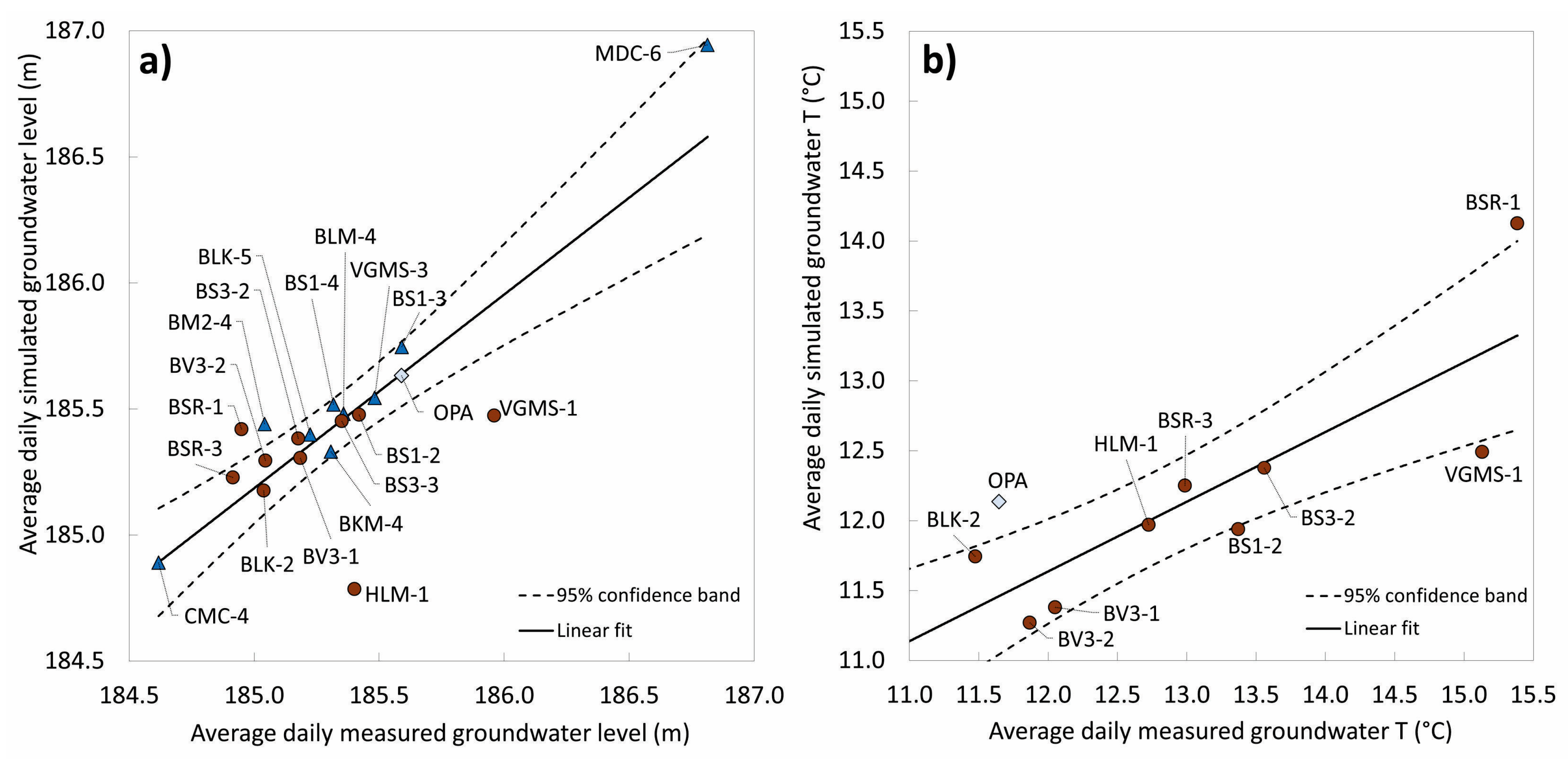
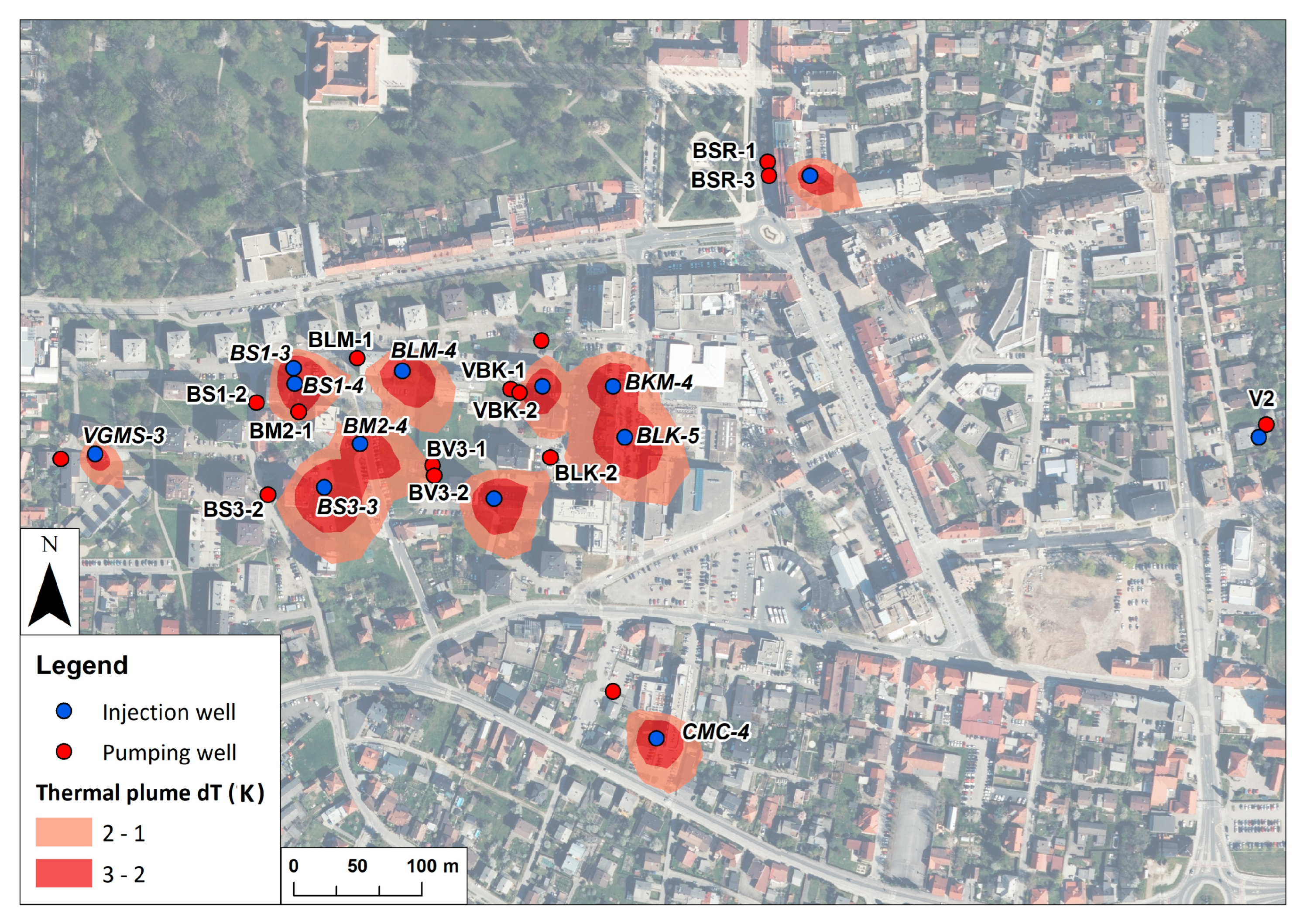
| Open-Loop System | Well Name with Assigned P or I Rate | GKX | GKY | Well Depth (m) | Filter Section Depth (m) | Type of Well | Number of Operating Days | Average P or I Rate (m3day−1) | Total P or I Volume (m3) |
|---|---|---|---|---|---|---|---|---|---|
| 1 | BS1-2/19 | 169114 | 589108 | 10.5 | 8.5–10.5 | P | 518 | ±194.102 | ±100,545 |
| BS1-3/19 | 169141 | 589137 | 10.5 | 8.5–10.5 | I | ||||
| 2 | BM2-1/19 | 169107 | 589141 | 10.5 | 8.5–10.5 | P | 504 | ±130.716 | ±65,881 |
| BM2-4/19 | 169082 | 589189 | 10.5 | 8.5–10.5 | I | ||||
| 3 | BS3-2/19 | 169042 | 589117 | 10.5 | 8.5–10.5 | P | 502 | ±217.833 | ±136,460 |
| BS3-3/19 | 169048 | 589161 | 10.5 | 8.5–10.5 | I | ||||
| 4 | BLM-1/19 | 169149 | 589187 | 12 | 9.0–11.0 | P | 542 | ±190.703 | ±103,361 |
| BLM-4/19 | 169139 | 589222 | 10.5 | 8.5–10.5 | I | ||||
| 5 | BLK-2/16 | 169071 | 589338 | 10.5 | 7.5–9.5 | P | 746 | ±258.922 | ±192,410 |
| BLK-5/16 | 169087 | 589396 | 10.5 | 7.5–10.5 | I | ||||
| 6 | MDC-2/18 | 170933 | 590922 | 12 | 10.0–12.0 | P | 735 | ±173.756 | ±126,976 |
| MDC-6/18 | 170849 | 590871 | 11.5 | 9.5–11.5 | I | ||||
| MDC-4/18 | 170945 | 590874 | 13.5 | 10.5–12.5 | P | 746 | ±179.110 | ±133,616 | |
| MDC-8/18 | 170857 | 590846 | 11.5 | 9.5–11.5 | I | ||||
| 7 | CMC-1/17 | 168888 | 589387 | 12 | 9.0–11.0 | P | 508 | ±140.075 | ±71,158 |
| CMC-4/17 | 168851 | 589421 | 12 | 9.0–11.0 | I | ||||
| 8 | BKM-1/19 | 169163 | 589331 | 11 | 8.0–10.0 | P | 466 | ±158.089 | ±73,669 |
| BKM-4/19 | 169127 | 589387 | 10.5 | 9.5–10.5 | I | ||||
| 9 | V1 | 169346 | 588570 | 10.5 | 8.5–9.5 | P | 746 | ±15.715 | ±11,723 |
| V1_P | 169343 | 588583 | 9 | 8.0–9.0 | I | ||||
| 10 | V2 | 169097 | 589898 | 9 | 8.0–9.0 | P | 746 | ±12.577 | ±9382 |
| V2_P | 169087 | 589892 | 6 | 6.0–9.0 | I | ||||
| 11 | V3 | 168804 | 588699 | 11 | 8.0–9.0 | P | 746 | ±17.294 | ±12,901 |
| V3_P | 168806 | 588709 | 10 | 8.0–9.0 | I | ||||
| 12 | VBK-1/16 | 169125 | 589307 | 10.5 | 8.5–10.5 | P | 683 | ±101.929 | ±69,618 |
| VBK-3/16 | 169127 | 589332 | 10.5 | 7.5–9.5 | I | ||||
| 13 | BV3-1/19 | 169065 | 589246 | 10.5 | 8.5–10.5 | P | 498 | ±216.639 | ±107,886 |
| BV3-3/19 | 169039 | 589294 | 10.5 | 7.5–9.5 | I | ||||
| 14 | BSR-1/19 | 169303 | 589508 | 10.5 | 8.5–10.5 | P | 494 | ±144.255 | ±71,262 |
| BSR-4/19 | 169292 | 589541 | 6 | 6–10.5 | I | ||||
| 15 | VGMS-1/13 | 169070 | 588955 | 12 | 8.5–9.5 | P | 746 | ±62.564 | ±46,673 |
| VGMS-3/13 | 169074 | 588982 | 12 | 8.5–9.5 | I | ||||
| 16 | HLM-1/14 | 168464 | 588480 | 9 | 8.0–9.0 | P | 550 | ±57.186 | ±31,452 |
| HLM-2/14 | 168459 | 588490 | 9 | 8.0–9.0 | I | ||||
| Drinking water supply | F-V1 | 169859 | 588789 | 11 | 5.0–9.0 | P | 746 | +935.418 | +697,822 |
| F-V2 | 169732 | 588631 | 11 | 5.0–9.0 | P | 738 | +866.003 | +639,110 | |
| F-V3 | 169673 | 588554 | 11 | 5.0–9.0 | P | 737 | +218.414 | +160,971 |
| Parameter | Initial Value | Lower Limit | Upper Limit |
|---|---|---|---|
| Hydraulic conductivity (kx,y) (ms−1) | 1.0 × 10−3 | 1.0 × 10−4 | 1.0 × 10−2 |
| Total porosity (Heat) (–) | 0.25 | 0.15 | 0.50 |
| Thermal conductivity of solid (Wm−1K−1) | 3 | 0.6 | 3.5 |
| Volumetric heat capacity of solid (Jm−3K−1) | 2.5 | 1.5 | 3.5 |
| Longitudinal/transverse dispersivity (m) | 5/0.5 | 4/0.4 | 30/3 |
| Well | Type of Well (P/I/O) | (m a.s.l.) | (m a.s.l.) | RMSE (m) | Measured (°C) | Simulated (°C) | RMSE (°C) |
|---|---|---|---|---|---|---|---|
| OPA | O | 185.59 | 185.63 | 0.14 | 11.6 | 12.1 | 0.85 |
| BS1-2 | P | 185.42 | 185.48 | 0.11 | 13.4 | 11.9 | 1.43 |
| BS1-3 | I | 185.59 | 185.75 | 0.16 | - | - | - |
| BS1-4 | I | 185.32 | 185.52 | 0.21 | - | - | - |
| BM2-4 | I | 185.04 | 185.44 | 0.40 | - | - | - |
| BS3-2 | P | 185.18 | 185.38 | 0.21 | 13.6 | 12.4 | 1.18 |
| BS3-3 | I | 185.35 | 185.45 | 0.08 | - | - | - |
| BLM-4 | I | 185.36 | 185.48 | 0.08 | - | - | - |
| BLK-2 | P | 185.04 | 185.18 | 0.16 | 11.5 | 11.7 | 1.30 |
| BLK-5 | I | 185.22 | 185.40 | 0.20 | - | - | - |
| MDC-6 | I | 186.81 | 186.94 | 0.15 | - | - | - |
| CMC-4 | I | 184.62 | 184.89 | 0.28 | - | - | - |
| BKM-4 | I | 185.31 | 185.33 | 0.20 | - | - | - |
| BV3-1 | P | 185.18 | 185.31 | 0.15 | 12.0 | 11.4 | 0.66 |
| BV3-2 | P | 185.05 | 185.29 | 0.25 | 11.9 | 11.3 | 0.71 |
| BSR-1 | P | 184.95 | 185.42 | 0.47 | 15.4 | 14.1 | 1.26 |
| BSR-3 | P | 184.91 | 185.23 | 0.18 | 13.0 | 12.3 | 0.82 |
| VGMS-3 | I | 185.48 | 185.54 | 0.14 | - | - | - |
| HLM-1 | P | 185.40 | 184.79 | 0.61 | 12.7 | 12.0 | 0.76 |
| VGMS-1 | P | 185.96 | 185.47 | 0.49 | 15.1 | 12.5 | 2.63 |
Disclaimer/Publisher’s Note: The statements, opinions and data contained in all publications are solely those of the individual author(s) and contributor(s) and not of MDPI and/or the editor(s). MDPI and/or the editor(s) disclaim responsibility for any injury to people or property resulting from any ideas, methods, instructions or products referred to in the content. |
© 2023 by the authors. Licensee MDPI, Basel, Switzerland. This article is an open access article distributed under the terms and conditions of the Creative Commons Attribution (CC BY) license (https://creativecommons.org/licenses/by/4.0/).
Share and Cite
Adrinek, S.; Janža, M.; Brenčič, M. Impact of Open-Loop Systems on Groundwater Temperature in NE Slovenia. Sustainability 2023, 15, 13797. https://doi.org/10.3390/su151813797
Adrinek S, Janža M, Brenčič M. Impact of Open-Loop Systems on Groundwater Temperature in NE Slovenia. Sustainability. 2023; 15(18):13797. https://doi.org/10.3390/su151813797
Chicago/Turabian StyleAdrinek, Simona, Mitja Janža, and Mihael Brenčič. 2023. "Impact of Open-Loop Systems on Groundwater Temperature in NE Slovenia" Sustainability 15, no. 18: 13797. https://doi.org/10.3390/su151813797
APA StyleAdrinek, S., Janža, M., & Brenčič, M. (2023). Impact of Open-Loop Systems on Groundwater Temperature in NE Slovenia. Sustainability, 15(18), 13797. https://doi.org/10.3390/su151813797






